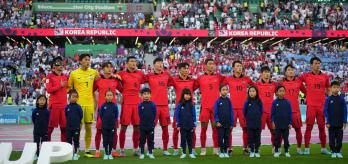Japan has developed rapidly as a football nation since it hosted the FIFA World Cup™ in 2002, but the Japanese Football Association (JFA) knows it still has work to do to achieve its aims. As part of its efforts to establish Japan among the world’s top football nations, the JFA came up with a philosophy it calls “Japan’s Way”, a tailored approach designed to meet specifically Japanese challenges.
Good practice
- Make use of opportunities to study and learn from other talent development programmes.
- Promote enjoyment at grassroots level at the same time as developing future international players - this is the rationale behind Japan's “double pyramid” system.
- Give smaller, local organisations (in Japan's case, regional football associations) the support they need to tailor their talent ID strategies to their local circumstances.
Watch presentation
Read summary
Part 1: Introducing “Japan’s Way”
Japan deliberately cut itself off from much of the world for three hundred years, and
when it opened up again in the 19th century, it was determined to assert itself as a great power. In that context, sport was seen as a way of strengthening the Japanese nation, and enjoyment was sidelined in favour of performance. This attitude is still prevalent today, and reports of athletes being abused are still relatively common. The JFA is determined to address this, which is one reason why it has sent a number of delegations overseas to study how other countries have built a positive football culture.
Part 2: The “double pyramid” model
The result of this research was a model the JFA calls the “double pyramid.” On the one hand, the grassroots side of the pyramid aims to get more Japanese playing and enjoying the game. As Kageyama explains, this is a challenge because youth football is dominated by school teams in which only a handful of youngsters play regularly, and many children “retire” from the game at 15 due to the pressures of the education system. On the other hand, the competitive side of the pyramid is geared towards developing future internationals. The competitive system is administered at local and regional level, with each Japanese local council (or Prefecture) taking responsibility for football development within its catchment area. The most promising players in each region are then invited to the national training centre just outside Tokyo.
Part 3: Japanese challenges
The final part of Kageyama’s presentation sets out some of the specific challenges facing Japanese football. The first of these is that Japan can be insular and inward-looking – only 17% of Japanese hold a passport – with the result that domestic competitions often lack intensity. This in turn leads some Japanese players to believe they cannot match up to their competitors abroad. At the same time, the association is also having to grapple with wider societal issues, such as a declining birthrate and an overwhelmingly male-dominated culture that disadvantages female players and coaches. Nevertheless, Kageyama is confident Japan can reach its goals, and that football can help to build a happier society across the country.



















